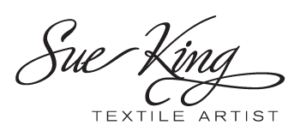I’m in Love (It’s not what you think)
*
Don’t get too excited, I’m talking about a new art technique that I absolutely love…silk screening. My art friends and I tried silk screening at last summer’s art retreat, with only minimal results. It sure seemed a whole lot more trouble than it was worth. We used directions featured in Quilting Arts magazine and after doing some of my own research on the topic, I found out that the directions were, shall I say, variations on a theme. Not recommended for the beginner and frankly, I’m not sure I would recommend the technique at all. The article suggested using gel medium to drag through the screen, and if you have used this medium, you know how thick and goopy it is. Physics alone would indicate there is going to be a problem trying to force it through the tiny holes in the screen.
*
After reading about the subject, it seemed as though we did not give this technique a fair shake. Other problems encountered were not using the proper screen size, correct mesh size and not degreasing the screen before use, all important facts that were left out of the article. For this summer’s retreat, I really wanted to try silkscreening again using the thermofax method. I still remember the smell of freshly mimeographed work sheets and tests from back in the day, sort of an elementary school high that was almost as good as eating paste (yes, there’s one in every class, but I’m not sayin’ it was me). The thermofax uses the old fashioned mimeograph machines to cut an image into a plastic film. I did an Internet search and found that Lyric Kincaid, http://www.lyrickincaid.com/, had the best prices and has what has to be the fastest delivery anywhere, except perhaps McDonald’s. You email her your image and she must burn them the minute they plop into her inbox. I had the returned thermofax in two days.
*
I purchased Photoshop Elements 8 last winter and used it to alter the original tree photo above. You could just xerox it, but if I’m going to lay out some cash for a new program, I’m going to use it. Besides it was really fun. Keep in mind that high contrast makes the best images for thermofax, and you can snail mail your image to Lyric with a check instead of doing the online route. An advantage to the thermofax technique is that you don’t need to use a screen, just put some duck tape around the edge and you are ready to go. You will need to purchase a squeegee. I got mine at Dick Blick.
*
Since we couldn’t get the regular silk screening to work last year because of the gel medium problem, (my friend Peggy said it took so much strength she thought she would throw her back out), I was determined to give it a try too. I had equally good results this time and just used a tree stencil on the back side of the screen to make a long horizontal row of trees. It was windy the day we were working, so there are some black marks in between the trees, but when quilted, these will become undergrowth.
*
I got the idea to make the trees reflect the changing of the seasons by dropping various colors of snippets on the screened trees.
*
I screened the original tree on to some different background fabrics, again with the idea of representing the seasons. I haven’t had time to do much else but look at these beauties on the design wall, but I hope to get at least two of them quilted for my solos show in July. It would be fun to screen some trees in different colors and perhaps on different fabrics like silk. I see pillows here, and I’m thinking Christmas gifts. So if you are attempting something new, the old adage, “If at first you don’t succeed, try, try again., ” may just be the answer to your problem.







